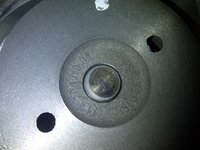Yes, there is very little torque on the auxiliary fans at low speed.
Water pumps can definitely make an engine run hot in the manner you describe. The impeller design may be incorrect. It may be pressed on to an incorrect depth. It could be pressed on backwards. It could have blades designed for a pump that rotates in the opposite direction. In that case, just as with any centrifugal pump or squirrel cage blower, the flow still runs in the correct direction, just much less efficiently.
AFAIK, thermostats were not modified to increase flow, but they were definitely modified to be more reliable over the long term. The earlier version old school thermostat design is prone to cracking at the wax element, wearing itself off center, and sometimes just fracturing in a few places. A similar design to the late version 119 thermostat was introduced with the M120, the M111, and just about every other gasoline engine across the board. Curiously, the M104, which by Mercedes standards has a voracious appetite for thermostats, retaind the old-school design right up through the end of production. Generally, this won't mean much to any of us these days, because, as supplied to MB from the various thermostat vendors, usually Wahler, Behr, Behr-Thompson, all of the old school thermostats in the M119, which if you did not know, were all actually last version M116/117 thermostats, were also modified to be more durable, and they are vastly superior to the first version of this thermostat, many of which developed broken wax elements and failed by sticking closed, usually well before 100,000 miles. In Central Florida, a bunch of them failed in the warranty period. That's why there is an early version part number still in the EPC carrying the dreaded "do not use, no longer to be installed, etc." footnote.
I have never seen a failure of the last version "everything is one piece with the cap" thermostat design, though I would definitely replace one of those also, when replacing the water pump, as I would with any thermostat design. And I would absolutely replace any thermostat may have been subjected to very hot coolant or steam.
So, to shorten this up to what matters, I would always replace a thermostat when replacing the water pump regardless of its design or age. I would not bother to retrofit a late version water pump/thermostat assemblage. I would replace any thermostat on an engine that has run or is running hot regardless of the original reason for the hot running.
Now, in the 124, you are pressed for space, but the thermostat is a piece of cake to change out in any other M119, so there is nothing stopping you from changing the thermostat first if there is any doubt. However, if you have access to a good digital/infrared thermometer, or perhaps even a contact thermometer that you could tape to the hoses, you could try this: When this thing is acting up and running hotter than high school love, check the temperature of the upper radiator hose and the lower radiator hoses. Especially with your auxiliary fans roaring away on high-speed, there should be a significant difference in temperature between the upper and lower radiator hoses if inadequate flow, either via defective thermostat, or defective pump is the issue.















